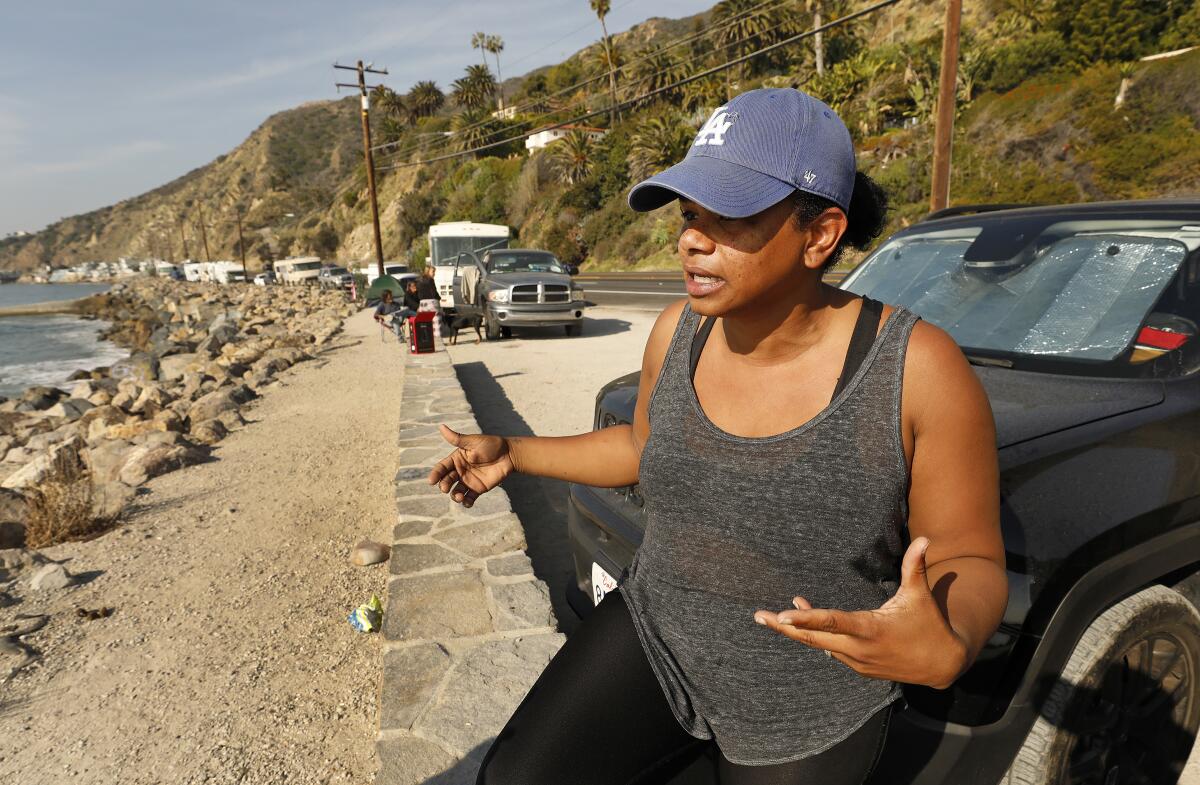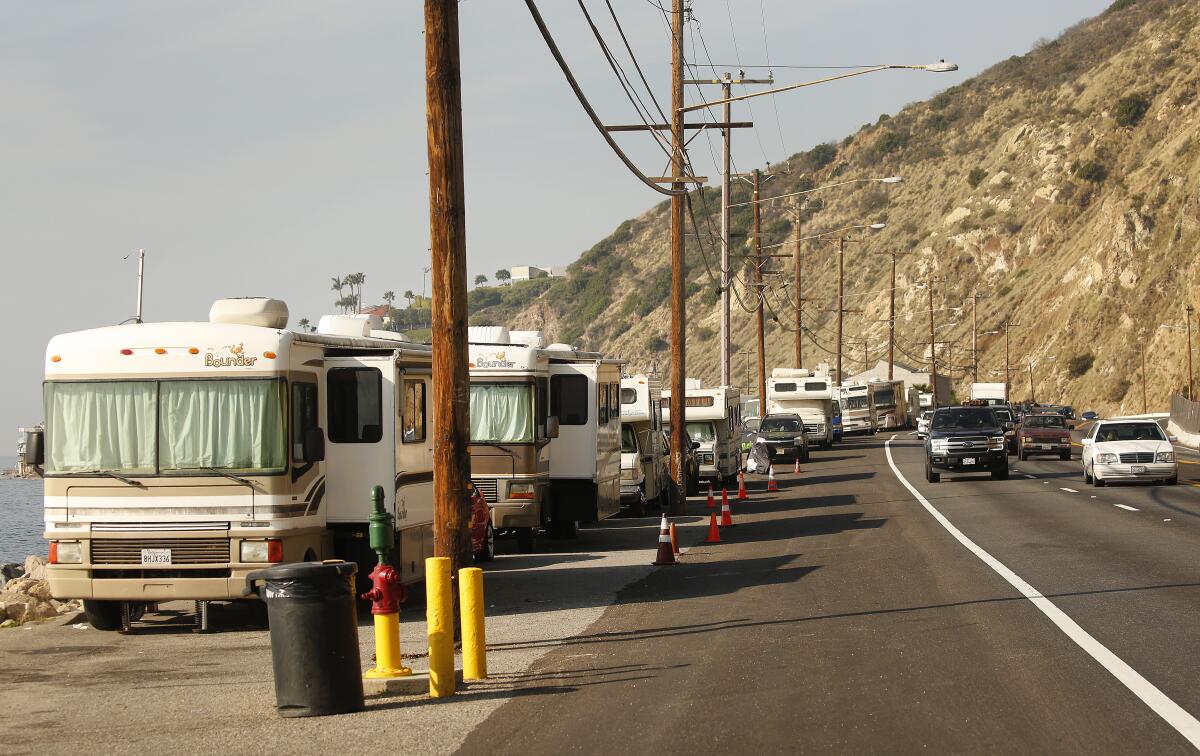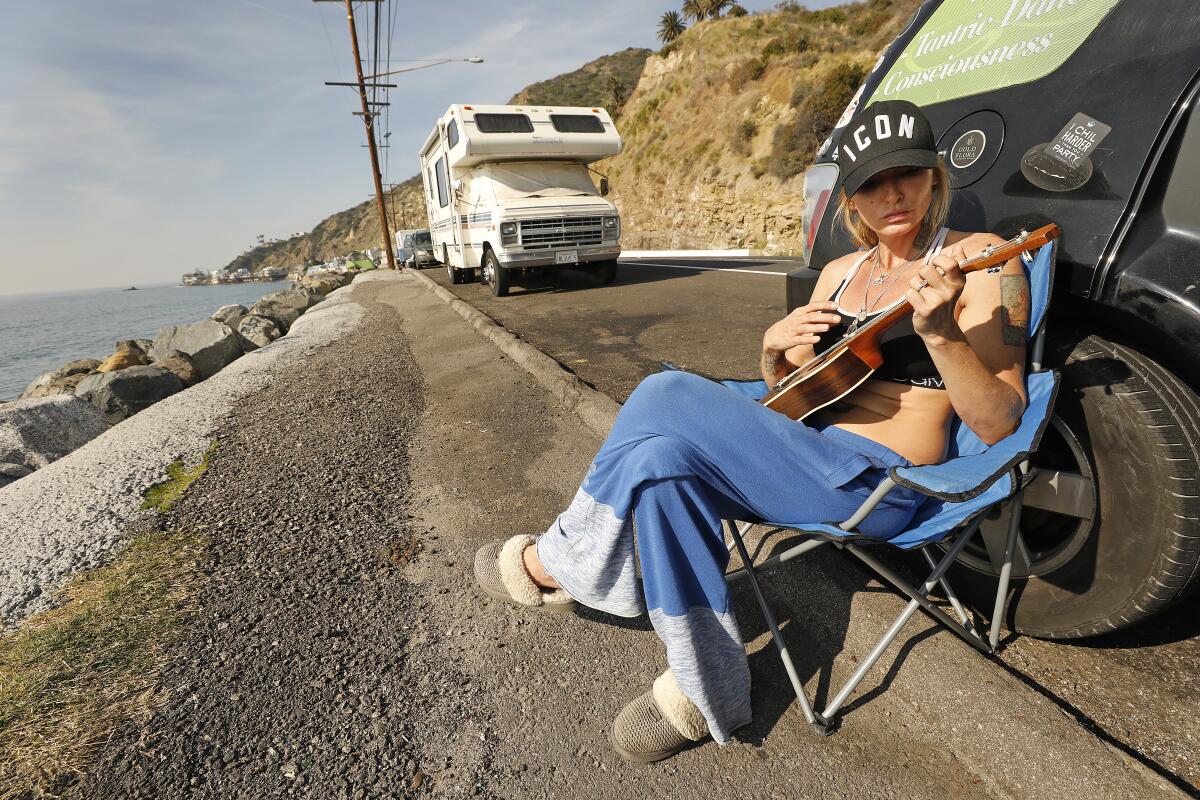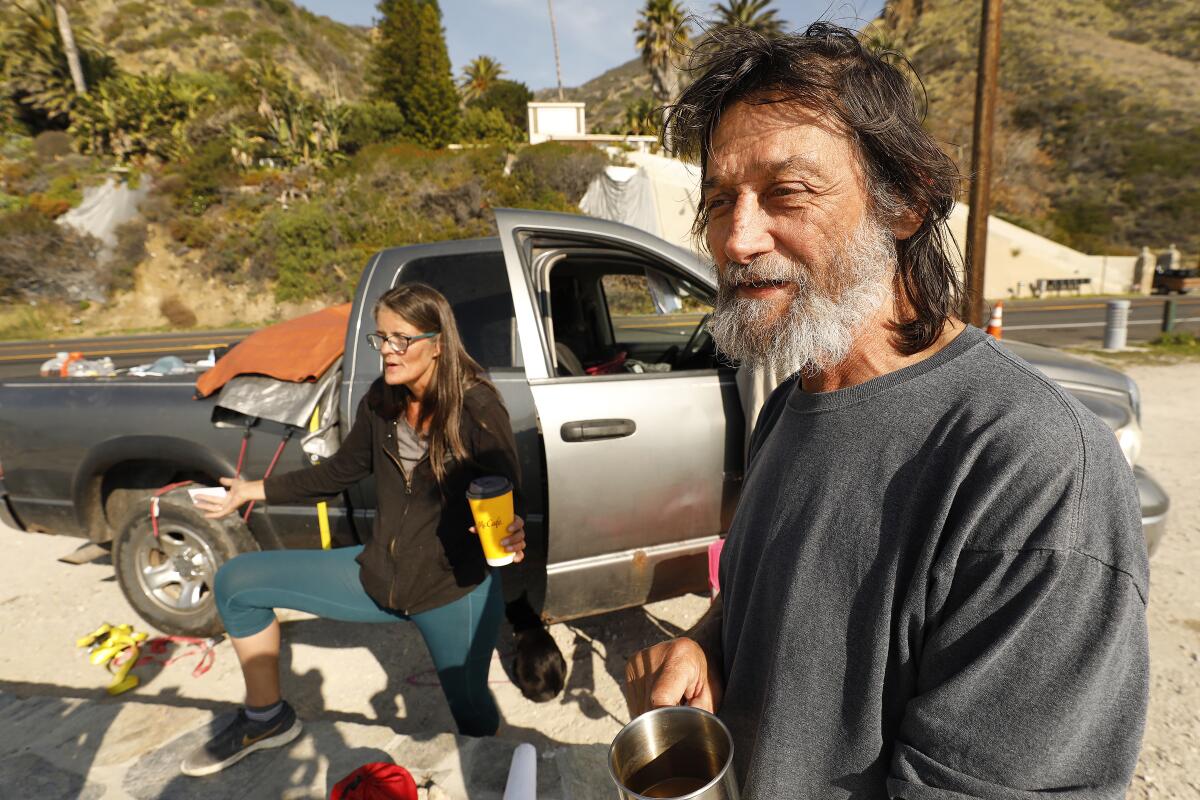Malibu wants to ban overnight parking on Pacific Coast Highway. Will the state allow it?

- Share via
Nidia Greiss pulled her Dodgers cap low over her eyes, squinting at a pair of tourists posed atop the lifeguard tower at Malibu’s Las Tunas Beach — the consummate #California shot.
Her husband, an Army veteran with tours in Iraq and Afghanistan, perched on the bumper of their spotless Jeep Renegade, watching traffic on Pacific Coast Highway. Las Tunas is less a beach than a backdrop. They’ve been here since August, living just out of frame.
“We were used to a comfortable life,” Greiss said. “We lived in Santa Monica for four years, but our apartment had mold and we broke ties with our landlord. It was too quick to find another place.”
The couple are among the more than 16,500 Angelenos who bed down in cars, vans and campers across the county every night. But legal spots are scarce. Last summer, the Los Angeles City Council voted to reimpose a ban on sleeping in vehicles on all residential streets, as well as on major thoroughfares near parks, schools and daycare facilities. Now, Malibu wants them off Highway 1.
“In my neighborhood, we have all these burned-out people, all these poor citizens who are paying their taxes, and they had to get a special permit to get a camper just to camp on their own land,” Malibu resident Cathey Cadieux told the City Council at its January meeting. “And yet we’ve got these people ... parked in front of Zuma Beach, and they’re just living there for free.”
Battered RVs and well-used camper vans have dotted the highway for years. But officials say large new encampments sprang up suddenly in Malibu after the L.A. County Department Public Works posted late-night parking restrictions on the city’s eastern border in November, making it functionally illegal to sleep there for more than a few hours at a time.
“It’s night and day,” Malibu City Councilman Mikke Pierson said of the change. “Las Tunas Beach is just one giant village at this point.”

The homeless population in Malibu remains relatively small, though it has grown in recent years. In 2019, the county identified 154 unsheltered people, about 100 of them living in vehicles. Most were concentrated in the area around the Malibu Pier.
By contrast, the tract that includes Las Tunas was barely a blip, with a homeless population that hovered in the single digits. Last year, volunteers counted four people. Ten times that many are living there now.
Similar encampments exist up and down the route, as coastal communities from Laguna Beach to Fort Bragg reckon with California’s homelessness crisis. But Highway 1 is Malibu’s arterial road. It hugs the city’s glittering shoreline, framing its most treasured views. Residents flooded the council, imploring the city to have the encampments removed.
“We basically have people homesteading on the beach areas,” resident Doug Stewart told the council at its January meeting. “We’re precluding the purpose of beach access, and that is let the citizens go visit the beach.”
Council members said they would love to do more. But only Caltrans can impose parking restrictions on Pacific Coast Highway, and only with the approval of the California Coastal Commission. The agency’s mandate is the zealous defense of public beach access, and since March, its decisions must also weigh environmental justice. Pushing caravans of mostly indigent people from the seaside runs afoul of both, state officials said.
“One of the major issues that the Coastal Commission brought up [in October] was the concern about displacing people who are homeless and affecting lower-cost access to the coast,” said Malibu City Planning Director Bonnie Blue. “We are looking for a path that will allow us to solve this problem — even if it’s incremental — that will hopefully not get hung up in a round of appeals.”
Malibu officials contend that those living on the highway are not homeless locals but out-of-state surfers and penny-saving snowbirds, and that the encampments themselves block public access to the beach.
“It’s the ultimate irony that the Coastal Commission’s focus is on coastal access, which is now being blocked bumper to bumper from one end of Malibu to the other,” Mayor Karen Farrer said. “But I fear [imposing restrictions] from one end of Malibu to the other, because if that gets turned down, we’re just back to square one.”
An incremental route may still have roadblocks. L.A. County spent two years in appeals to get a pair of alternating two-hour limits on less than a mile of pavement. Malibu’s share of the highway is almost 30 times that long.
“It seems like we’re getting screwed over by the Coastal Commission,” City Councilman Skylar Peak said at the hearing. “They got us on this one.”
Those living on the side of the road said they felt equally trapped.
“This is all we have left,” said Sharon Bodine, 40, who has lived on PCH for months. “If we’re not breaking laws, leave us alone.”

About 50 people were camped along the highway’s seaward shoulder at Las Tunas on a recent weekday morning. One, Mike Picone of Buffalo, N.Y., said he was traveling for the winter and preferred the Malibu roadside to the Santa Monica RV park.
“I did this years ago — I had no idea it was looked at as like a step away from homelessness now,” the visitor said. “In the ‘90s, it was nothing like this.”
His RV was one of several vehicles with out-of-state plates, though few of his neighbors could be called tourists.
“I sent a picture and told my daughter that I have Malibu oceanfront property,” said Elizabeth Dobbs, 54, of Libertyville, Ill., who recently gave up her beloved Great Dane to shelter another homeless family in the truck where she lives.
Greiss joked she and her husband chose Las Tunas over the West L.A. Veterans Affairs campus for its breathtaking views. But others said the highway was an avenue of last resort.
“I was parked in the neighborhood [in Santa Monica], but the cops told me to go to PCH,” said Norma, an immigrant and a surfer who splits her time between friends’ couches and her antiquated Toyota Tercel. “This spot has to be protected for people who live here. Where else am I supposed to go?”

Residents, too, worried about moving the caravans from an area that is essentially uninhabited to a more popular part of Malibu.
“I feel this is going to push the encampments,” resident Keegan Gibbs told the City Council ahead of a vote earlier this month. “They’re parked in ultimately the most ideal area right now, where there are no residents. Las Tunas doesn’t even have a beach that you can visit, or at least dry sand.”
The city voted to authorize overnight parking restrictions along a quarter-mile section of the highway at Las Tunas, and a similar stretch near the Malibu Pier, with plans to add sections of Corral Beach, Westward Beach and Zuma.
As with the unincorporated county, the ordinance would forbid parking between midnight and 2 a.m. on the inland side of the highway, and from 2 a.m. to 4 a.m. on the coastal side.
It’s not clear whether the Coastal Commission will see those as the same.
Los Angeles County was able to secure its restrictions in part because it funds “safe parking” sites, where people can legally sleep in their cars. Though the program has space for fewer than 3% of the people who need it, Malibu has no provisions for vehicle dwellers at all.
“We have to make a stand at some point,” Pierson said. “If we don’t, I very strongly suspect that the state or the federal government will do it for us.”
For now, the highway remains a refuge.
“It’s probably going to be more of a growing subculture as people can’t afford rent,” said Picone, the Buffalo tourist. “I’ve been here 3½ weeks, and there’s guys that have been here the whole time. Why the hell would you want to leave once you’ve found this spot?”
More to Read
Sign up for Essential California
The most important California stories and recommendations in your inbox every morning.
You may occasionally receive promotional content from the Los Angeles Times.







